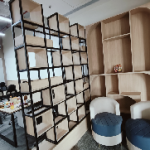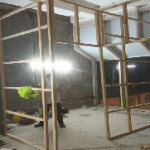Prefabricated House Manufacturers in Delhi - Future Ready Living Solutions
In recent years, the demand for sustainable and affordable yet efficient housing has led to the emergence of prefabricated houses in Delhi and other cities & towns in India. These homes have recently become a trendy alternative to the traditional houses constructed following conventional construction methods. Recognized as the top prefabricated houses company in Delhi NCR, we deliver high-quality prefab solutions that meet modern housing needs. Known also as the best commercial interior designers, our expertise extends beyond homes to creating functional and aesthetic commercial spaces.
Prefabricated house service in Delhi NCR, also referred to as modular or prefab homes, is built off-site in a controlled factory environment and later transported to the desired location for assembly. This innovative prefabricated home service in Delhi offers several benefits, including time efficiency, cost-effectiveness & environmental sustainability. Let’s delve deep into the world of prefabricated houses and explore the several reasons contributing to their growing popularity.

The Concept of Best Prefabricated Houses in Delhi NCR
Prefabricated houses are built using systematic procedures where different structure components, like roofs, walls, and floors, are manufactured off-site. These components, called panels or modules, are constructed in factories with specialized facilities, advanced machinery, and appropriate techniques. Once prepared, the modules are then transported to the site where they are assembled to create a fully functional and sustainable prefabricated house.
The top prefabricated houses company in Delhi is building prefabricated houses for numerous clients in Delhi and adjoining cities. Prefabricated houses in Noida are also becoming very prevalent in the present times. This entire process of building prefabricated houses ensures complete precision, reduces the overall construction time, and also minimizes the generation of waste.
Additionally, many of these companies also offer the best retail design services, ensuring that commercial prefabricated spaces are not only efficiently built but also aesthetically pleasing and functionally optimized for businesses.
Pros of Prefabricated Home/Houses
Cost-effectiveness
Prefabricated houses are usually cost-effective compared to traditionally built on-site homes. The streamlined production process, economies of scale & reduced labour costs contribute invariably towards lowering the overall construction expenses. Additionally, the controlled factory environment minimized the wastage of construction materials, eventually leading to additional savings.
Time-efficiency
The offered prefabricated houses service in Gurgaon and other cities are usually much faster processes as compared to the traditional homes that are built on-site. As the modules are being fabricated simultaneously while the necessary preparations for assembly on the site are also being conducted. Thus, the overall time of construction is reduced significantly. This aspect makes the prefab houses an ideal choice, especially for those looking for quick housing solutions under certain circumstances like urgent accommodation needs or in disaster-stricken areas.
The flexibility of design
Contrary to conventional belief, the best-prefabricated houses in Dehradun and other cities offer many design options. The manufacturers provide different floor plans & several types of customizations that allow homeowners to personalize their homes as per their preferences. Additionally, the nature of modular construction makes it much easier to expand or modify the prefabricated house in the future.
Sustainability
We are one of the top prefabricated houses companies in Dehradun that believes in offering sustainability as the prefabricated houses are known for their eco-friendly attributes. The construction process at our end is factory-controlled, and this aspect reduces wastage and promotes the efficient utilization of resources. Additionally, prefab houses are usually equipped with certain sustainable features like the placement of energy-efficient appliances, solar panels as well as advanced & efficient insulation systems. All of these lead to reduced energy consumption and lower bad environmental impact.
Prefabricated houses are transforming the housing industry through efficiency, affordability, and sustainability. With rising demand for eco-friendly options, they offer a viable solution for all. Their design flexibility, reduced construction time, and environmental benefits are paving the way for sustainable living. This includes a focus on the best product design in Delhi, ensuring homes are both functional and beautiful. From family homes to cozy cottages, prefab houses are truly changing how we build and live.
We at Brandroot Interiors & Architects offer the best prefabricated houses in Delhi NCR and other towns, and have been making remarkable strides in the trend of owning a prefabricated house. We are just a call away to discuss your requirements and expectations. Give us a call at + 91 7291906016 or email us at brandrootinteriors@gmail.com to share your brief and to discuss your requirements.
Frequently Asked Questions (FAQs)
1. What exactly is a prefabricated house ?
2. How do prefabricated houses differ from a traditional home?
The main difference lies in the construction location and process:
- Traditional Homes: Built entirely on-site, from the ground up, using standard construction methods (e.g., brick by brick, stick-built).
- Prefabricated Houses: Built in a factory environment, minimizing weather delays and allowing for efficient, quality-controlled manufacturing. The final assembly on-site is much quicker.
Prefab homes often result in faster build times, greater cost certainty, and less material waste. Traditional homes typically offer more design freedom for large, complex, or completely bespoke designs.
3. What materials are commonly used in prefabricated houses built by manufacturers in Delhi?
Manufacturers in Delhi and India often use a variety of materials, including:
- Steel/Mild Steel: Used for the main structure, including modular frames and light gauge steel framing, known for durability.
- PUF Panels (Polyurethane Foam Panels): Often used for walls and roofs for good insulation and rapid construction.
- FRP (Fiber-Reinforced Polymer/Plastic): Used for lightweight and portable cabins or house sections.
- Aerocon/Cement Panels: Used for walls and partitions.
- Wood: Used for certain types of prefab homes, like cottages, or as a material for the frame and interior finishes.
4. How much does a prefabricated house cost in India?
The cost of a prefabricated house in India varies significantly based on factors like:
- Materials used (Steel, PUF, FRP, wood, etc.)
- Level of customization and finishes (basic shelter vs. luxury home)
- Size and complexity of the design.
- The manufacturer and region.
Based on industry listings in and around Delhi, prices can vary depending on the design, materials, and type of modular home. It is important to get a detailed quote that specifies whether it includes foundation, transportation, assembly, and internal fittings (turnkey cost).
5. Is a prefabricated house more affordable than traditional construction?
Generally, yes, a prefabricated house is often more affordable than comparable traditional construction. This is due to:
- Reduced Labor Costs: Quicker assembly means less on-site labor time.
- Material Efficiency: Factory-controlled construction reduces material waste through precise cutting and bulk purchasing.
- Time Savings: Shorter construction timelines mean lower costs for temporary accommodation or construction financing.
While the upfront cost might sometimes be similar, the efficiency and speed of prefab often translate to better cost certainty and overall savings.
6. How long does it take for a prefabricated house to be fully constructed?
The timeline is significantly shorter than traditional construction. While a traditional home can take many months (4 to 12 months or more), a prefabricated house can often be completed in a much shorter period:
- Manufacturing: The components are built in the factory, which can take several weeks to a few months.
- On-site Assembly: Once the foundation is ready and the components are delivered, the on-site assembly can often be completed in a matter of weeks (sometimes as quickly as a few days for smaller units).
The total time from design to move-in varies, but the process is much faster than traditional on-site building.
7. Are prefabricated houses durable, weather-resistant, and safe?
Yes, modern prefabricated houses are designed to be durable, weather-resistant, and safe.
- Durability: They are built with high-quality, often industrial-grade materials like steel frames and engineered panels. The components must be structurally sound enough to withstand transportation and lifting, often resulting in robust construction.
- Weather-Resistant: Construction in a controlled factory environment ensures consistency and tight tolerances, which leads to better seals, waterproofing, and insulation. They are often built to withstand specific local climate conditions.
- Safety: Reputable manufacturers build their homes to meet or exceed local building codes and standards. Materials like galvanized steel offer excellent resistance to pests (like termites) and fire.
8.Can I customize the design, layout, and finishes of a prefabricated house?
Yes, a high degree of customization is possible, though it may vary by manufacturer and the specific type of prefab system (modular vs. panelized).
- Design & Layout: While some manufacturers offer standard floor plans, many allow you to tailor the layout, size, and even architectural style (modern, cottage, etc.). Modular systems are often highly flexible.
- Finishes: Homeowners can typically choose from a wide range of options for exterior cladding, roofing, flooring, wall finishes, cabinets, and fixtures. Full customization, however, may increase the cost and complexity compared to standard models.
9. What is the typical lifespan and maintenance requirement of a prefabricated house?
Lifespan: With good materials (especially steel frames) and proper maintenance, the lifespan of a modern prefabricated house can be 30 to 70 years or more, often comparable to traditional stick-built homes. High-quality steel structures can potentially last 50 to 100 years.
Maintenance: Prefabricated homes generally require a moderate level of maintenance, similar to or sometimes less than traditional homes. This includes:
- Regular inspections of the roof, joints, and seals.
- Checking the foundation for shifting or cracks.
- Protecting materials (like painting the exterior every few years) against sun, moisture, and temperature fluctuations.
- Maintaining HVAC systems.






